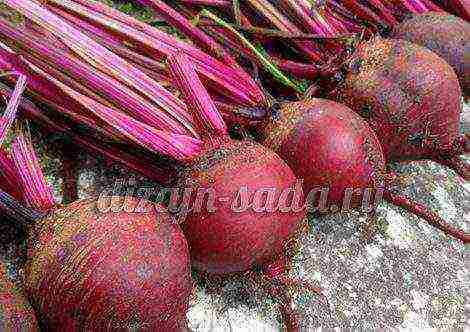Content
- 1 Early varieties of eggplant
- 2 Mid-season varieties
- 3 Eggplant varieties for greenhouses
- 4 Open ground varieties
- 5 The best multi-colored varieties
- 6 The best purple varieties
- 7 The best varieties for the Moscow region
- 8 Eggplant in a purple outfit
- 9 White eggplant
- 10 Lilac eggplant
- 11 Green eggplant
- 12 Red, orange, yellow
- 13 Which eggplants can be grown outdoors?
- 14 Eggplant planting tips from an experienced gardener
- 15 The most successful early varieties of eggplant for open beds
- 16 The best mid-season eggplant varieties for open soil
- 17 Unusual eggplants for an open garden
- 18 Four tips from gardeners for a good eggplant harvest
Eggplant varieties with photos and descriptions
This page contains varieties and hybrids of eggplant for greenhouses and open ground, tall and undersized, early and mid-season, of various colors, shapes and sizes.
Eggplant Diamond
A mid-ripening variety of eggplant for cultivation in the open field. The period from full germination to harvest is 110 - 150 days (depending on the region of cultivation). In the middle lane, it is recommended to plant seedlings in greenhouses and film shelters. The variety is resistant to drought and other adverse weather conditions. Suitable for mechanized harvesting.
The Almaz eggplant variety was included in the State Register and approved for use in the Ural, Far Eastern, Middle Volga, Lower Volga, Central Black Earth, West Siberian and North Caucasian regions.
The bush is compact, 50–55 cm high. The leaves are green, medium in size, broadly oval in shape. Corolla is light purple. The calyx is greenish-purple, without thorns, which makes harvesting easier.
Fruits are glossy, cylindrical, 14.5-17.5 cm long, 3 to 6 cm wide. At biological maturity, eggplants have a brown-brown color. The average weight of the fruit is 100-165 g. The pulp is greenish, dense, not bitter.
Yield eggplant Diamond: 2.1 - 7.5 kg / sq. m.
Advantages of the variety: high and stable yield, unpretentiousness, good taste of fruits, excellent transportability.
Flaws: a large number of seeds in the eggplant, the lower fruits are in contact with the soil.
Eggplant King of the North
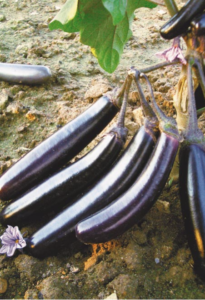
An early ripe hybrid, stable with a stable yield and excellent fruit set. The period from full germination to the first harvest (technical ripeness) is 95–100 days. This hybrid was bred specifically for the harsh climatic conditions of the northern regions of our country, and therefore received this name.
This variety is recommended for outdoor cultivation. Even in Siberia, it is possible to get good harvests in the open field. When grown in greenhouses and greenhouses, the plant is too hot, and there is also the possibility of being affected by a spider mite.
The bush is over 1 meter high. The stems are bright purple. Fruits are elongated-cylindrical, glossy, black-violet, 25-30 cm long (sometimes 40 cm). White pulp, excellent taste, no bitterness. The peduncle has no thorns.
It is a hybrid of long-term fruiting. Each plant bears up to 10 fruits.
Eggplant yield King of the North: 12 - 15 kg / sq. m.
Landing scheme: 60 x 40 cm.
Dignity eggplant King of the North: cold resistance, unpretentious care, lack of barren flowers, resistance to fungal diseases and temperature extremes.
Flaws: Due to the large size, the eggplants touch the ground, so it is advisable to mulch the soil under them with sawdust or straw.
Your reviews of the King of the North eggplant will help many gardeners evaluate it objectively and decide whether to plant this hybrid or not.
Eggplant Marzipan
Mid-ripening medium ripening period from the company Russian vegetable garden. The period from germination to technical ripeness is 120–125 days. This variety tolerates the heat and drought of the south, but is also great for growing in the northern regions.
For a bush of this variety, support is required, since under the weight of the fruit it can fall to the ground.
The fruits are very fleshy, without bitterness and practically without seeds, have a sweetish aftertaste. The peel is glossy, dark purple in color. The average weight of the fruit is 300-400 grams, the length is up to 15 cm.
Dignity Marzipan varieties: excellent fruit taste, resistance to unfavorable growing conditions.
Yield eggplant Marzipan: 1.5-2.5 kg per plant.
Eggplant Epic
An early ripe classic Dutch hybrid eggplant. Included in the State Register of the Russian Federation in 2008. Recommended for cultivation in the southern regions. The period from planting seedlings in the ground to technical ripeness takes 65 days.
The bush is powerful, tall (90-100 cm), erect, semi-spreading, with high vigor. Stem medium pubescent, with low to medium anthocyanin coloration. Leaves are green, medium in size.
Fruits are glossy, cylindrical, even in shape and size (average length - 22 cm, diameter - 10 cm), dark purple in color, weighing 220 - 230 grams. The eggplant pulp is dense, white, without bitterness and practically without seeds. The calyx is covered with sparsely spaced spines.
Yield eggplant Epic: up to 5.8 kg per sq.m.
Dignity: high yield, resistance to temperature extremes and tobacco mosaic virus, excellent taste of the fruit.
Eggplant Black handsome

Mid-season eggplant variety for open ground and greenhouses. The period from germination to harvest is 110 - 145 days. The originator of the variety is the Poisk firm. The variety is included in the State Register for the Central Black Earth and North Caucasian regions of the Russian Federation.
Semi-spreading bush, 60-80 cm high, with short internodes. Pubescent stems with anthocyanin coloration. Leaves are green, medium-sized, slightly toothed, with thorns.
Fruits are elongated pear-shaped, glossy, smooth, weighing 110-200 g, 18-20 cm long, violet-black at the stage of full maturity. The pulp is yellowish, tender, without bitterness, practically without seeds. The skin is thin.
Eggplant yield Black handsome: up to 6.5 kg per sq. m.
Advantages of the variety: high yield, disease resistance, unpretentiousness, amicable ripening and high taste of the fruit.
Eggplant Clorinda
Mid-early, super-yielding Dutch eggplant hybrid of high commercial quality for fresh consumption and processing. It can be grown in open ground, under film shelters, in a greenhouse.
Erect bush with short internodes, 90-100 cm high. Leaves are medium-sized, green.
Fruits are oval, up to 25 cm long and up to 12 cm wide, brilliant-black at maturity, glossy, with dense whitish flesh and almost no seeds. No bitterness. Eggplant can weigh up to 1.5 kg.
It is recommended to sow eggplant seeds for seedlings in mid-February, to a depth of 1-1.5 cm. Hybrid eggplant seeds germinate from 7 to 14 days, depending on the temperature, humidity, freshness of the seeds. When planting seedlings in a permanent place, it is advisable to maintain a distance in a row of 25-30 cm and between rows of 50-60 cm.
Yield eggplant Clorinda F1 high.
Eggplant Bourgeois
Early maturing (period from germination to ripening 105-110 days), high-yielding, large-fruited hybrid of eggplant for open ground and film shelters.
The bush is powerful, semi-spreading, of medium height. Leaves are medium in size, green, with notched edges.
Fruits are spherical, smooth, shiny, black-purple in color, weighing 400-500 g, of high taste. The eggplant pulp is greenish-white, tender. These eggplants are recommended for all types of culinary processing.
This eggplant is sown for seedlings at the end of February, then to be planted in open ground when the threat of return frosts has passed. Landing scheme into the ground: 40 x 60 cm.
The value of the hybrid: a combination of early maturity and large-fruited, the absence of bitterness in the fruits, a long fruiting period.
Eggplant yield Bourgeois 1.5-2 kg per plant.
Video about eggplant marzipan
Reviews of eggplant varieties
If you are growing any good eggplant varieties that deserve to be ranked in the top 10 best eggplant varieties, please write these varieties. If possible, give them a description and attach a photo of these varieties. What do you think is better eggplant f1 or varietal eggplant?
Your reviews and additions will help our readers choose the best and most productive varieties and hybrids of eggplant for planting.
It is advisable to indicate the growing region in the comments. Thus, we will select the best varieties of eggplant for the Moscow region, Siberia and the Urals, the middle belt, the Northern regions and various regions of our vast country.
Review of eggplant varieties, video
Eggplants Esaul, Ermin, Clorinda, Bibo - a cutaway fruit, the number of seeds in it, taste, thickness of the skin.
Choosing the best for your garden, you automatically choose not only the quality of vegetables, excellent characteristics and taste, but also give yourself the opportunity to use a minimum of labor costs. Eggplant is a vegetable among the varieties of which any gourmet can find to his liking, and no matter what size, color, yield you prefer, there is plenty to choose from. Let's take a look at the best ones.
Early varieties of eggplant
Early eggplants are good not only for the quick ripening of long-awaited vegetables, but also for the opportunity to get a full harvest in the northern regions. If in May you do not have the opportunity to plant eggplants in the ground, and in June night frosts are possible, it is worth choosing early varieties for your garden. Choose hybrids for your garden that have proven themselves among farmers and gardeners.
King of the north
Hybrid with high resistance to frost, subject to hardening of young shoots. Ripeness occurs at 90 - 100 days, but many note that in 70 - 80 days, the fruits can already be fully formed.
It is possible to remove from 3 to 4 kg of even purple cylinders from one plant.
The taste is quite delicate, a small amount of voids even at maximum maturation. Stored at a temperature of 12 - 15 degrees for up to two months, ideal for preparing blanks.
Bibo
This is a white-skinned eggplant with super early ripening. After 60 - 70 days, you will remove up to 15 even and smooth snow-white vegetables weighing up to 500 g from one bush. It is unpretentious, and perfectly pollinates and matures both in the greenhouse and in the ground.
Black handsome
The black handsome variety has an ideal dark shade, the fruits are small, up to 200g, but up to 3 kg can be removed from one root. After 70 - 80 days, it gives a friendly harvest, but it is worth protecting from the first frosts, it requires additional shelter.
Mid-season varieties
These eggplants are best used in regions where there are no unexpected frosts, or grown in a greenhouse. Due to the longer ripening period than in early ripening ones, you should carefully monitor the temperature in the greenhouse. The more stable the temperature and humidity, the richer the crop will be.
Albatross
If you like teardrop-shaped eggplants, round, fleshy, without voids, then this is your option.A variety for fresh consumption, conservation and long-term storage. Easy to transport, has a high keeping quality, this has become the main reason for choosing among farmers.
Diamond
One of the most favorite eggplant of gardeners in the middle lane. It is considered a dwarf bush, but very branchy, formed in the form of a ball. Decorative. Aging period up to 80 days. You can get up to 8 kg from one bush. Fruit weight up to 180g. The formation of flowers occurs from June to August, and the fruiting in this regard is long.
Marzipan
Connoisseurs of the delicate and tasty pulp of this eggplant prefer it not only for this reason. Ripens in 110 - 120 days, has a beautiful pear-shaped shape, deep purple hue.
Eggplant varieties for greenhouses
High-yielding varieties grow well in greenhouses, they require care, but respond to it with amicable and good fruiting. Stable temperature and humidity allow you to choose tall plants - from each such bush you can remove from 5 to 12 kg of vegetables.
Robin the Hood
A mid-season hybrid, requires the formation of a bush, but has a low growth of up to 60 cm. The plant has thorns. Pear-shaped, rounded fruits with low bitterness, ripening at 90 days. Medium keeping quality, for all types of canning and cooking.
 Description of the variety Robin Hood
Description of the variety Robin Hood
Policeman
Tall, up to 240 - 260 cm, ripens up to 120 days from the time of planting. Fruits ranging in size from 20 to 35 cm, yield - up to 9 kg. Requires the formation of a bush, it is enough to leave 2 stems, on which up to 15 fruits ripen at the same time.
Excellent taste for both fresh and salted consumption.
It can be stored fresh for up to 2.5 months, loses its presentation a little, dries out, but the taste remains.
Sophia
A late-ripening variety with large fruits. Ripe fruits reach 30 cm and weigh up to 900g. The bush is up to 150 cm high, forms itself, but pinching is required. Up to 17 kg can be removed from one plant. very dense purple fruits. Perfectly stored and transported, the shelf life is the highest among all varieties with such a productivity - up to 3 months.
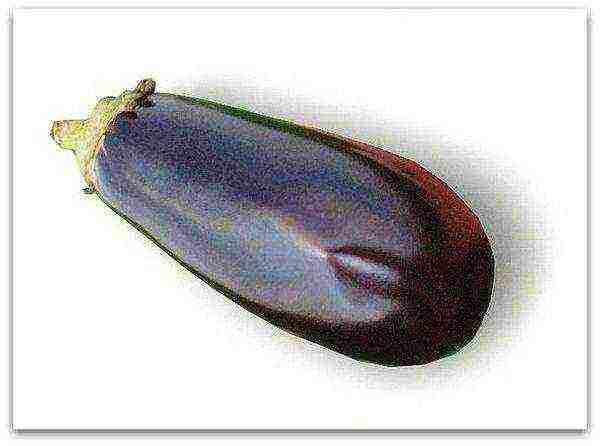 Eggplant Sophia
Eggplant Sophia
Open ground varieties
If you plan to grow your eggplant outdoors, suitable frost-resistant varieties are essential. In the middle lane, even the most patient vegetable to temperature changes requires shelter for the period of night frosts. Only zoned hybrids are ideal for a greenhouse.
Vakula
Patient enough to temperature changes, you can plant seedlings at the end of May. Height up to 120 cm, has a strong and dense stem. Pinching is not required, the bush forms itself. Up to 8 kg of eggplant can be removed from one bush.
Bull heart
Does not tolerate spring frosts, therefore, plant in open ground after their end. Rounded fruits weighing up to 300g, bush up to 80cm, yield about 8 - 12 kg. Unpretentious in agricultural technology, but does not tolerate overflow.
Alekseevsky
One of the best outdoors. The height of the bush is up to 70 cm, very branchy, fruits up to 150g, but in one season it is realistic to collect up to 9-10 kg. A garter is required, as the bush is very fragile.
The best multi-colored varieties
The white-skinned varieties were bred in order to get rid of the bitterness, which is contained precisely in the coloring enzyme. Eggplants of other colors were obtained by crossing.
Swan
One of the best white eggplants. It has not only white skin, but also flesh. Can be grown both in soil and in a greenhouse. The height of the bush is up to 70 cm., The weight of the fruit is up to 250 g. The yield of one plant is up to 6 kg.
Icicle
Unusual due to its shape, which is why it is attractive. Bush up to 80cm. Fruits up to 300g. Up to 5 kg can be removed from one bush.
Flamingo
The name speaks for itself - beautiful pink, curved fruits weighing up to 40hg. They are in time for 130 days. Shrub up to 180cm, spreading and high-yielding. Up to 16 kg can be harvested from one plant.
Purple Haze
Dark pink fruits weighing up to 180 g, ripen, on average, in 120 - 130 days. Bush up to 150cm, branched. It is afraid of frost, in a greenhouse up to 5 kg can be removed from one plant.
Yoga
Unusually - green fruits, reminiscent of curled corn. Each weighing up to 250g., Up to 20cm long. The bush is up to 80 cm, semi-spreading, does not require formation. The pulp and rind have no bitterness.
Emerald
Bright green fruits weighing up to 300 g., Ripen on average up to 100 days. The plant tolerates temperature extremes and mild drought. From one root in 120 days, you can get up to 5 kg of vegetables.
Chinese lantern
In 80 - 110 days after sowing, at 70 cm, unusual eggplants begin to turn red in the bush. Unusual bright color and shape makes them look like decoration. Weight up to 180g, yield - up to 3 kg per plant.
The best purple varieties
Even the fact that new bright colors of the vegetable with low bitterness appeared did not distract from the standard purple favorites. Among them, the leading varieties are:
King of the north
Resistant to frost, technical ripeness for 90 - 100 days, but can be removed for 70 - 80 days. Up to 4 kg of even purple, very beautiful fruits are removed from the bush.
Purple miracle
Hybrid. It tolerates drought patiently, but it is necessary to use a lot of water one time. The bush is up to 90 cm high. Beautiful elongated fruits weighing up to 250g. Maturation at 90 - 115 days. From one plant, you can get up to 8 kg of eggplant.
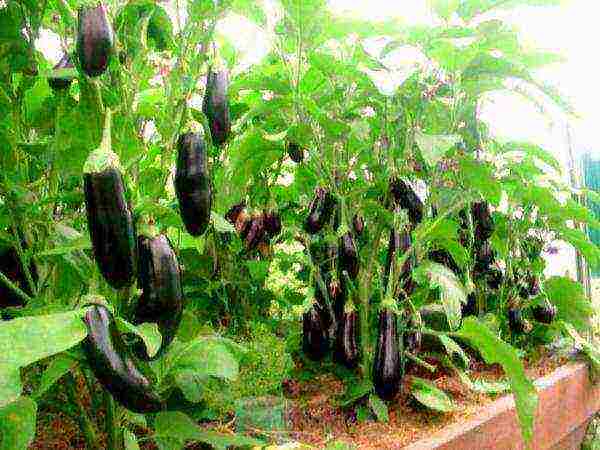 Purple miracle
Purple miracle
Diamond
Dwarf variety. Height up to 50 cm, but the bush is very branched. It looks very decorative, in the form of a ball, does not require shaping. Ripeness for 80 days. Fruits up to 180 - 200g.
During the season, you can get up to 8 kg of beautiful bright purple fruits.
The best varieties for the Moscow region
The middle lane is a rather mild climatic zone, but late summer and early autumn do not allow late-ripening varieties to fully ripen. Greenhouses help with this, but it is still worth choosing early and mid-season varieties.
These varieties will give an excellent harvest and bring a minimum of hassle:
- King of the north. Will give an excellent harvest in the absence of frost in early summer. It proved to be excellent both in greenhouses and in the ground;
- Black Prince. It is worth choosing it not only because of its decorative effect. The rich purple color hides the delicate pulp without bitterness, and from one bush it is possible to get fruits up to 8 kg.;
- Sophia. Even when planting in the ground, and covering in the first week, you will receive up to 15 - 17 kg of large, up to 900g per season. Eggplant.
- Albatross. Mid-season, but ripening early enough. On day 90, the first fruits can be removed. Beautiful cylindrical shape and delicate taste. Patient about drought;
If you dream of a friendly and high harvest, minimal labor costs and pleasing to the eye vegetables, you should choose seeds zoned for your area, provide proper care, and do what you love with pleasure.
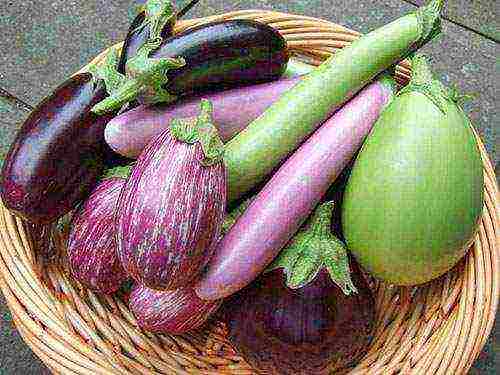 The list of species and varieties of garden plants in the beds of summer cottages and household farms is expanding every year. If not long ago a rare gardener decided to grow eggplants, today this and many other crops are quite common and give good yields in various parts of the country. Cultivating tomatoes, cucumbers, sweet peppers, plant several bushes of the eggplant variety you like in the garden to please your family with delicious dishes.
The list of species and varieties of garden plants in the beds of summer cottages and household farms is expanding every year. If not long ago a rare gardener decided to grow eggplants, today this and many other crops are quite common and give good yields in various parts of the country. Cultivating tomatoes, cucumbers, sweet peppers, plant several bushes of the eggplant variety you like in the garden to please your family with delicious dishes.
When the basics of agricultural technology are mastered and the first purple fruits are harvested, it's time to choose varieties and types of eggplants for planting next season. And there really is something to see, especially since thanks to breeders from all over the world, eggplants have long ceased to be only "blue". Now in the beds among the bushes with traditionally purple fruits, you can see white, green, variegated, and almost pink eggplants.
There are plants that produce yellow, orange and even red fruits, which outwardly differ little from sweet peppers or tomatoes, but inside they remain real eggplants.
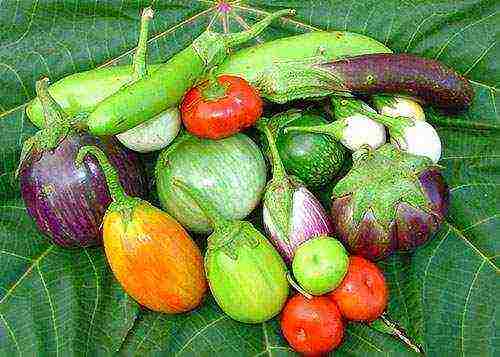 In addition, today you can choose eggplant varieties and their hybrids:
In addition, today you can choose eggplant varieties and their hybrids:
- forming tall or compact plants;
- giving the usual cylindrical or surprising round, ovoid and long serpentine fruits;
- striking in yield and size of individual fruits, up to 2 kg in weight;
- different ripening periods;
- for growing in greenhouses, greenhouses or in the open field;
- resistant to diseases and unpretentious to growing conditions in the middle lane.
The choice of varieties and types of eggplant is so great that it is no wonder it is easy to get confused. If experienced summer residents know how to handle many varieties of plants in the beds, then for beginner gardeners it is more reasonable, having familiarized themselves with the characteristics of all kinds of eggplants in advance, to choose a couple or three early-ripening varieties in order to guarantee themselves tasty and healthy vegetables.
Eggplant in a purple outfit
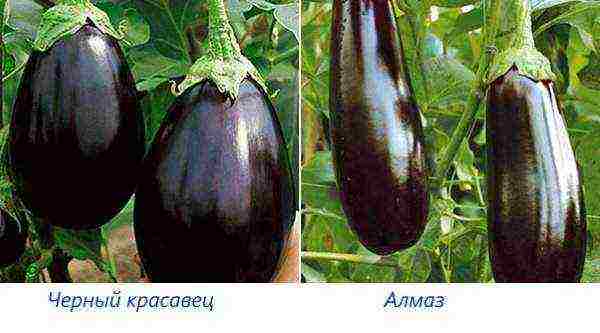 Traditionally, in Russian gardens, purple eggplants are in the lead in popularity, and the palm tree belongs to two varieties of eggplants almost throughout the country.
Traditionally, in Russian gardens, purple eggplants are in the lead in popularity, and the palm tree belongs to two varieties of eggplants almost throughout the country.
This is the Black Beauty variety, attracting the attention of gardeners not only for its unpretentiousness and the ability to grow, both in film greenhouses and in the open field, but also for its decent yield and quality of fruits. Dense brown-purple eggplants weighing 200-350 grams do not have a bitter taste, are well stored and are not susceptible to common diseases of this culture.
The second in the garden popularity rating is the Almaz eggplant variety, which is distinguished by 200-gram deep purple fruits. The shape of the fruit is oblong, even, the pulp has a pleasant taste without signs of bitterness.
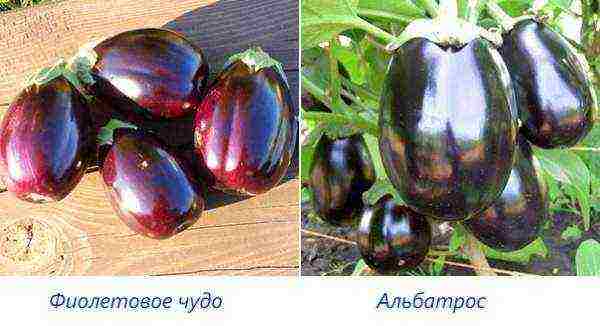 In addition to these well-known varieties, other varieties are worthy of attention of gardeners:
In addition to these well-known varieties, other varieties are worthy of attention of gardeners:
- giving a lot of medium-sized, oblong fruits, weighing up to 150 grams, the Violet Miracle variety;
- eggplant variety Banana with elongated fruits that can be stored for a long time without loss of quality;
- large-fruited variety Black Beauty with fruits up to 900 grams, bright black-purple color.
 Adherents of the traditional pear-shaped shape will like the productive Albatross variety, which forms compact bushes from which large, up to 450 grams in weight, blue-violet fruits with dense greenish pulp are removed.
Adherents of the traditional pear-shaped shape will like the productive Albatross variety, which forms compact bushes from which large, up to 450 grams in weight, blue-violet fruits with dense greenish pulp are removed.
Round eggplants, which are gaining popularity, are convenient for stuffing, canning and stewing, so varieties and hybrids that produce fruits of this shape are becoming more and more in demand.
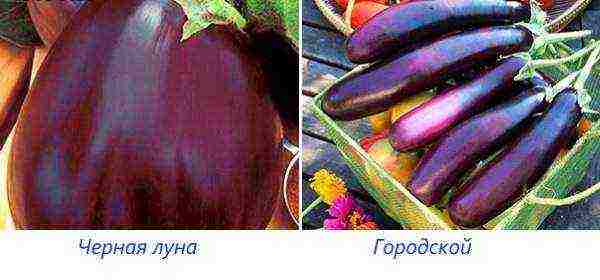 An example of a plant of this type is the Black Moon variety of domestic selection, which gives almost ribbed spherical fruits of a dark purple color with a glossy surface and light green flesh without traces of bitterness. Eggplants weighing 200 to 350 grams can be harvested as early as 110–115 days after planting, and the ovary forms even at low temperatures, and the plant bears fruit for a long time.
An example of a plant of this type is the Black Moon variety of domestic selection, which gives almost ribbed spherical fruits of a dark purple color with a glossy surface and light green flesh without traces of bitterness. Eggplants weighing 200 to 350 grams can be harvested as early as 110–115 days after planting, and the ovary forms even at low temperatures, and the plant bears fruit for a long time.
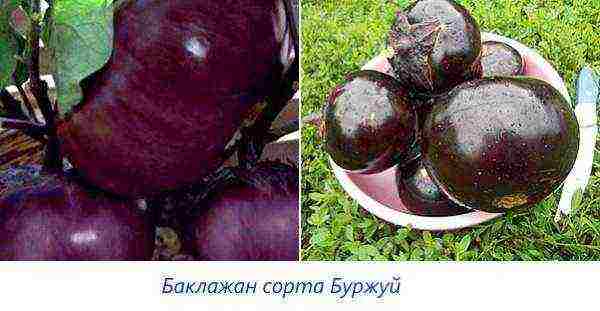 The high-yielding early Bourgeois hybrid also produces round eggplants with a glossy black-purple surface and an almost white, delicate flesh. Fruit weight reaches 400-600 grams.
The high-yielding early Bourgeois hybrid also produces round eggplants with a glossy black-purple surface and an almost white, delicate flesh. Fruit weight reaches 400-600 grams.
For cultivation in film and winter greenhouses, you can choose the Gorodovoy F1 eggplant of a medium ripening period, characterized by a high stable yield, excellent taste and transportability of fruits. The plant is powerful, reaching a height of more than 1.8 meters, it bears large cylindrical fruits up to 0.5 kg in weight.
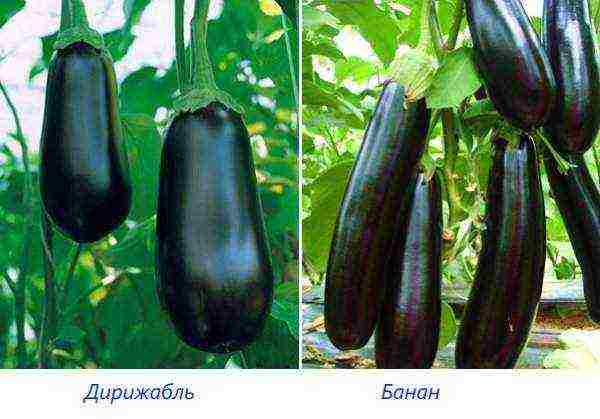 The eggplant variety Airship is in no way inferior in yield, whose fruits weighing up to 120 grams can be harvested in 125-135 days from the moment of germination. Due to the dense crown and the abundance of foliage, yields may drop, so plants of this type of eggplant require thinning and removal of excess stepsons and leaves.
The eggplant variety Airship is in no way inferior in yield, whose fruits weighing up to 120 grams can be harvested in 125-135 days from the moment of germination. Due to the dense crown and the abundance of foliage, yields may drop, so plants of this type of eggplant require thinning and removal of excess stepsons and leaves.
White eggplant
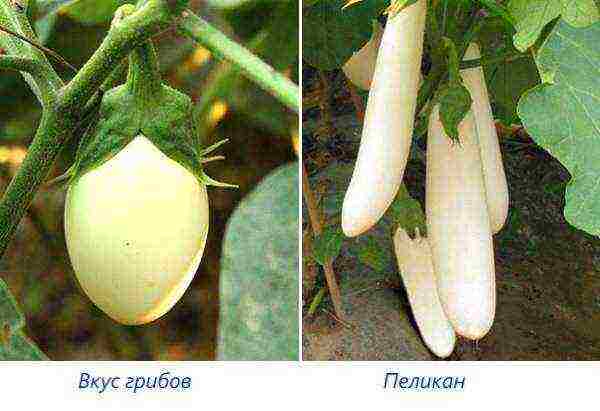 If a few years ago eggplant with a white peel could surprise neighbors in a summer cottage, friends and acquaintances, today these varieties of eggplant have won well-deserved recognition and are loved by many gardeners. This became possible not only because of the exotic appearance and unusual, as in the photo, eggplant color, but also thanks to the delicate, almost seedless, white pulp without any bitterness and taste, according to gourmets, reminiscent of mushroom or chicken.
If a few years ago eggplant with a white peel could surprise neighbors in a summer cottage, friends and acquaintances, today these varieties of eggplant have won well-deserved recognition and are loved by many gardeners. This became possible not only because of the exotic appearance and unusual, as in the photo, eggplant color, but also thanks to the delicate, almost seedless, white pulp without any bitterness and taste, according to gourmets, reminiscent of mushroom or chicken.
Domestic gardeners who decide to try themselves in growing white eggplant should pay attention to early varieties and hybrids that give good yields even in not the most favorable conditions.
In 95-105 days after the seeds are hatched, the domestic variety of eggplant yields a crop Taste of mushrooms, which can be cultivated both in open ground and in greenhouses or film greenhouses. As you can see in the photo, the color of the eggplant is really milky white. Cylindrical fruits weigh 200-250 grams and stand out from a number of analogues with a pleasant mushroom smell, delicate pulp and high marketability.
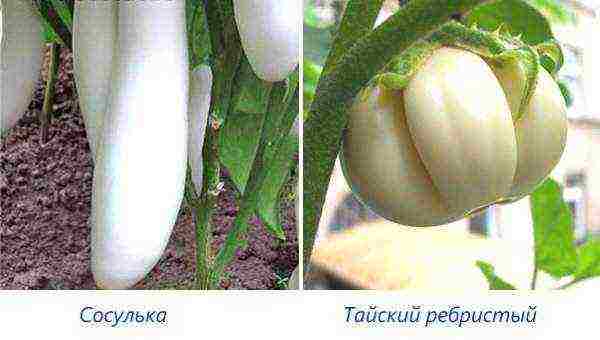 The Icicle variety bears fruit a little later, after 110-116 days, and not only the color, but the type of eggplant is surprising. The long fruits really do resemble an icicle, taste good and are great for all types of culinary processing. Another eggplant variety has a similar, saber-shaped fruit shape, in the photo of white color - Pelican. Gardeners can also take a closer look at other white-fruited varieties, for example:
The Icicle variety bears fruit a little later, after 110-116 days, and not only the color, but the type of eggplant is surprising. The long fruits really do resemble an icicle, taste good and are great for all types of culinary processing. Another eggplant variety has a similar, saber-shaped fruit shape, in the photo of white color - Pelican. Gardeners can also take a closer look at other white-fruited varieties, for example:
- to the Swan variety with fruits of a classic cylindrical shape;
- to eggplant Iceberg, which produces fruits in the form of an oval or egg;
- to round ping-pong eggplants.
Lilac eggplant
 In addition to purple and white eggplants, breeders have obtained many intermediate forms that have striped, pink-white or lilac fruit color. From an eggplant variety Lilac to wait for the fruit should be after 98-106 days. The plant forms a compact bush with a height of no more than 60 cm, while the fruits have an elongated-cylindrical shape, lilac surface and weight from 150 to 250 grams. On the cut, the fruit is white, dense. Good-tasting pulp can be used for all types of food and canning.
In addition to purple and white eggplants, breeders have obtained many intermediate forms that have striped, pink-white or lilac fruit color. From an eggplant variety Lilac to wait for the fruit should be after 98-106 days. The plant forms a compact bush with a height of no more than 60 cm, while the fruits have an elongated-cylindrical shape, lilac surface and weight from 150 to 250 grams. On the cut, the fruit is white, dense. Good-tasting pulp can be used for all types of food and canning.
Fans of amicable bountiful harvests will appreciate the Balagur variety, which forms up to 7 fruits on the clusters. And the value of the variety is not only this, but also in the early stages of ripening, the excellent commercial quality of 150 gram elliptical eggplants and their excellent taste.
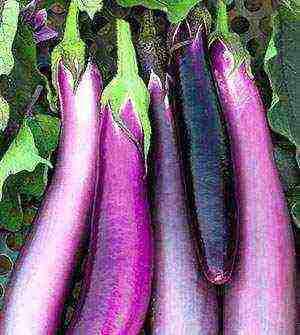 The variety Pink Flamingo belongs to the medium early eggplant, which grows up to 180 cm in height under the conditions of heated greenhouses. Fruits, as in the previous case, are formed on clusters of 3–6 pieces. The weight of one eggplant is 250-450 grams. Especially the pink-lilac color of the eggplant, as well as the white, without bitterness, flesh draws attention to the variety.
The variety Pink Flamingo belongs to the medium early eggplant, which grows up to 180 cm in height under the conditions of heated greenhouses. Fruits, as in the previous case, are formed on clusters of 3–6 pieces. The weight of one eggplant is 250-450 grams. Especially the pink-lilac color of the eggplant, as well as the white, without bitterness, flesh draws attention to the variety.
Round eggplants, as a rule, are large in size and impressive fruit weight. Bumbo is no exception. Its spherical fruits have an interesting white-lilac hue and weigh up to 700 grams. The best results are obtained from cultivation in a greenhouse, where the plant forms powerful bushes, showing a consistently high yield.
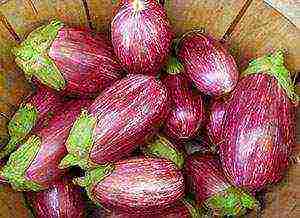 From a number of lilac, pink and purple counterparts, the Matrosik eggplant variety shown in the photo stands out for its spectacular striped color of oval or pear-shaped fruits, weighing 100-150 grams each.
From a number of lilac, pink and purple counterparts, the Matrosik eggplant variety shown in the photo stands out for its spectacular striped color of oval or pear-shaped fruits, weighing 100-150 grams each.
Green eggplant
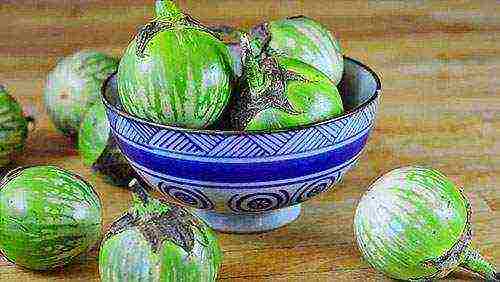 In Southeast Asia, small round eggplants with a solid or variegated green color are very popular. In Europe and the USA, eggplants with the color as in the photo are usually called Thai, but Chinese types of eggplants of this type are also known. For example, at the stage of technical ripeness, the fruits of the Chinese green eggplant have a light green color, but when they ripen, they change it to golden-bronze.
In Southeast Asia, small round eggplants with a solid or variegated green color are very popular. In Europe and the USA, eggplants with the color as in the photo are usually called Thai, but Chinese types of eggplants of this type are also known. For example, at the stage of technical ripeness, the fruits of the Chinese green eggplant have a light green color, but when they ripen, they change it to golden-bronze.
Domestic breeders have not forgotten green eggplants either. The Zelenky variety bears pear-shaped green fruits weighing from 250 to 300 grams. The pulp of such eggplants does not contain bitterness, has a white or barely greenish color and a wonderful taste of natural mushrooms.
 The Emerald eggplant variety shown in the photo belongs to the early maturing, can be cultivated both under the film and in the open field. On unpretentious, cold-resistant bushes, large, cylindrical elongated fruits weighing 300-400 grams are formed with a creamy white pulp of medium density.Eggplants of this variety are tasty, not bitter and invariably delight with high yields.
The Emerald eggplant variety shown in the photo belongs to the early maturing, can be cultivated both under the film and in the open field. On unpretentious, cold-resistant bushes, large, cylindrical elongated fruits weighing 300-400 grams are formed with a creamy white pulp of medium density.Eggplants of this variety are tasty, not bitter and invariably delight with high yields.
Red, orange, yellow
 Eggplants of yellow, orange and purple color are almost impossible to find in our gardens. And yet, these types of eggplant exist.
Eggplants of yellow, orange and purple color are almost impossible to find in our gardens. And yet, these types of eggplant exist.
The bright sunny fruits of yellow color and oval shape are given by the eggplant variety Golden Eggs presented in the photo, obtained by Dutch breeders. The eggplant pulp of this variety is rich in carotene, and the rest of the vegetable is similar to its more familiar garden relatives.
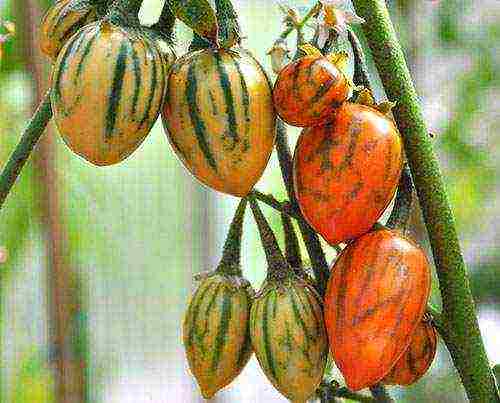 Being of African or Middle Eastern origin, Turkish eggplants are distinguished by their miniature size and the orange-striped color of the fruit that appears as it ripens. Young fruits of this type of eggplant are green, fragrant, without traces of bitterness, but gaining color, they begin to noticeably bitter. These thermophilic plants are popular in South America, where they came several centuries ago with slaves, and are valued for the lycopene contained in fruits, which is used to obtain anticancer drugs.
Being of African or Middle Eastern origin, Turkish eggplants are distinguished by their miniature size and the orange-striped color of the fruit that appears as it ripens. Young fruits of this type of eggplant are green, fragrant, without traces of bitterness, but gaining color, they begin to noticeably bitter. These thermophilic plants are popular in South America, where they came several centuries ago with slaves, and are valued for the lycopene contained in fruits, which is used to obtain anticancer drugs.
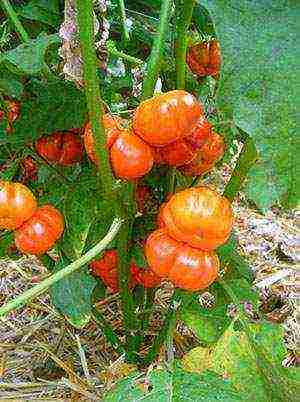 Red, more like miniature tomatoes or pumpkins, eggplants are grown both for small fruits and as an ornamental plant. The plant forms sprawling bushes. The leaves of this type of eggplant and the trunk, covered with sparse thorns, are often burgundy or purple in color. The fruits hold well on the stalks, on the cut they resemble jalapeno peppers, they are quite edible, but when ripe they can taste bitter.
Red, more like miniature tomatoes or pumpkins, eggplants are grown both for small fruits and as an ornamental plant. The plant forms sprawling bushes. The leaves of this type of eggplant and the trunk, covered with sparse thorns, are often burgundy or purple in color. The fruits hold well on the stalks, on the cut they resemble jalapeno peppers, they are quite edible, but when ripe they can taste bitter.
The best varieties and hybrids of eggplant - video
Eggplants are vegetables that will provide you with delicious taste and tons of nutrients when grown and cooked correctly. The fruits of this culture are used for the preparation of first and second courses, salads and preservation. India is considered the birthplace of the "blue" ones. It was from this country that eggplants were brought to Russia in the 18th century. To be successful in growing this valuable and tasty vegetable in your garden, you need to choose the best varieties of eggplant for outdoor use. We will show you how to do this today.
But first, watch a short video:
Which eggplants can be grown outdoors?
Eggplant is a very thermophilic crop that grows well in warm, sunny places. For planting in open ground in the Russian climate, early and early-middle varieties are suitable, with a ripening period of up to 125 days. Mid-season eggplants only mature in a greenhouse or in the gardens of southern Russia.
In our area, various varieties, hybrids and even exotic colorful eggplants are successfully grown. There are varieties of this vegetable that are bred for a seedless growing method, but experts recommend growing eggplant seedlings for open ground. So you increase the efficiency of planting and move the ripening time of the fruits to the optimal summer period.
Eggplant planting tips from an experienced gardener
To choose the right eggplant varieties that will give you a really good harvest, you need to determine the individual parameters for your future plantings:
- Fruit ripening period;
- Mass (ripeness) and yield of the variety;
- The duration of the fruiting period;
- Winter hardiness, sensitivity to watering, shade tolerance and disease resistance of the selected varieties.
And also consider an illustration:
Another way to effectively grow eggplants is shown in the figure. The seeds are sown in early March, and then the seedlings are dived into peat forms. You can plant eggplants in the ground together with pots. All summer, eggplants require careful care: timely watering, spraying from pests and fertilizing. The upper inflorescences from the bush are removed so that the lower fruits can fully ripen
And a few more master classes:
Knowing all the listed characteristics, you can plan a combination of varieties that will provide you with fruits from the first summer months, until the onset of cold weather. Choose varieties for frying, stewing, baking and preparing winter preparations, and delicious eggplants will be on your table all year round.
The most successful early varieties of eggplant for open beds
Alekseevsky
Ideal for a short summer. The fruits are tied and ripe together, have an excellent taste. The pulp of this variety is dense and homogeneous, without veins. The shape of the fruit is oblong, cylindrical, and has a dark blue color.
Alekseevsky is an irreplaceable variety for the harsh conditions of the North. It perfectly tolerates sudden drops in temperature, responds well to any care and has a high resistance to disease. Fruits of dark blue oblong shape do not taste bitter and can be stored fresh for a long time
Vakula
A popular variety among Russian gardeners. Tall bushes grow up to 1.5 meters, give abundant fruit setting and amicable ripening. Shiny dark purple fruits have a pleasant taste without bitterness, they are used for any preparation.
Vakula is a large-fruited variety, problem-free in cultivation. The bushes of this eggplant grow up to 1.5 meters, so they need good support. The fruits are tied and ripen together, are large in size and have excellent taste.
Banana
An early ripening variety with good taste, suitable for frying and preservation. Bushes "Banana" give many side shoots with fruits. The variety got its name due to the shape and size of the eggplants themselves, which are similar to bananas. The disadvantage of this variety is its low frost resistance, so seedlings can be planted not earlier than June.
An excellent early ripe eggplant variety - "Banana". In the photo we see that the plant got its name due to the characteristic shape of the fruit. The bushes are thermophilic, low. The fruits themselves have a pleasant taste and can be stored for a long time.
Negus
A valuable variety, highly popular in our area. Small fruits ripen quickly and taste great. The main advantages of this eggplant are the duration of fresh storage and the continuous ripening of new fruits. The crop can be harvested every 10 days.
Negus is a very famous early maturing eggplant variety. The fruits are massively tied and ripen on low bushes. Their flesh is white, tasty, without bitterness and streaks. The variety has an interesting feature - to quickly resume the harvest. If you have collected ripe eggplants, then after 10 days new fruits will appear on the bushes.
Valentine
An excellent eggplant with dark purple cylindrical fruits. Domestic gardeners appreciate the taste of Valentina and the fact that its peel is resistant to cracking.
In the photo we see an excellent variety of eggplants "Valentina". It produces tasty fruits of the correct cylindrical shape. The peel of the variety is resistant to damage, so the eggplants are well stored and transported. "Valentina" is perfectly adapted to our conditions and provides the owners with fruits before the cold weather
Joker
Super productive carpal hybrid. The fruits are tied in large numbers with brushes and ripen together, which allows you to take large harvests at a time. Eggplants are purple in color with light veins. The pulp is tasty, without bitterness and large seeds.
If you want to harvest bountiful harvests, be sure to plant a super productive hybrid "Balagur" in your garden. Its small fruits are tied with tassels and ripen very quickly. Eggplant tastes great and has a beautiful purple-blue coloration.
Drakosha
Small fruits of this variety are pear-shaped. The variety is highly prized for its excellent taste and pleasant pulp texture. It is suitable for cooking any kind of food, it is resistant to many diseases and perfectly tolerates a drop in temperature in cold summer conditions.
King of the North
One of the favorite varieties of the inhabitants of the northern regions of Russia.It grows well in cool conditions, is disease resistant and produces a bountiful harvest. Fruit taste without bitterness, with moderate pungency. The pulp is white, not sinewy.
The King of the North is an eggplant with a “telling” name. This variety is ideal for growing in northern conditions. Medium-sized bushes give abundant yields of oblong fruits with white flesh. Eggplants are well stored and transported
Premier
Large-fruited early eggplant with excellent taste, without bitterness. Resistant to disease, cold and untimely watering. It is planted in open beds at the end of May.
Black Prince
A versatile variety for any climate. The fruits ripen together, have a slightly oblong cylindrical shape and excellent taste. The Black Prince produces crops even with minimal maintenance.
Eggplants "Black Prince" ripen early and very amicably. The fruit of this variety has a beautiful dark purple color and is suitable for any preparation method. The main value of the variety is unpretentiousness to care and climatic conditions. "Black Prince" will bear fruit even in a cool cloudy summer
Nutcracker
A very early and thermophilic hybrid. The plant is planted in June in open ground, but in July you can harvest small purple fruits with excellent taste.
In addition to those described above, varieties such as Vera, Galina, Long Pop, Marzipan, Murzik, Robin Hood, Epic, Japanese dwarf, etc.
The best mid-season eggplant varieties for open soil
Diamond
A very valuable high-yielding variety, rich in vitamins and microelements. Bushes grow compact, like the fruits themselves. Ripe Almaz eggplants have a brown-brown color and glossy shine. The variety perfectly tolerates storage and transportation, is suitable for second courses and preservation.
Almaz eggplants grow well both in the southern regions and in more severe conditions. The yield of this variety will depend on the timing of planting seedlings in the ground. In the southern regions, "Almaz" can be planted in mid-May, and in cool summer conditions - early June. The variety bears abundant fruit before the onset of a cold snap.
Albatross
Large-fruited variety with excellent frost-resistant characteristics. The fruits grow up to 500 grams in weight, have a flattened shape and a dark purple-blue color. The taste of the variety is very high; ripe vegetables are suitable for preservation and frying.
Albatross is a large-fruited eggplant with excellent characteristics. The pulp tastes without bitterness, does not contain veins and large seeds. This variety is used for any dishes: steamed vegetables, grilled, main courses, caviar. Also, good preparations for the winter are obtained from this vegetable.
Baltic
Heat-loving eggplant, which is best grown in the southern regions of Russia. With good care and proper watering, it gives very bountiful yields, therefore it is often grown by gardeners for sale.
hippopotamus
An excellent variety for the Moscow region and Siberia. The bushes are frost-resistant, have a natural immunity to typical diseases. The fruits of the variety with white pulp are pleasant to the taste, do not have bitterness. The yield of this species is very high.
Variety "Begemot" has proven itself well in Russian beds. Eggplants are dark blue in color, wide oval in shape and rather large in size. The fruits are tasty, well stored and can be used for frying and canning
Clorinda
High-yielding medium early hybrid for open beds. Fruits are compact with a beautiful dark blue color. The bushes are not tall, but require a garter. The plant tolerates a drop in temperature well in late May - June.
Roma
Ideal for cool summer regions. In addition to being unpretentious to growing conditions, it is very fruitful and tasty. The soft, slightly greenish pulp of the oblong fruits is not bitter and does not contain streaks.
Black handsome
A high-yielding and disease-resistant eggplant variety.The fruits have a beautiful dark color and excellent taste. The only drawback of the "Black Beauty" is its heat-loving nature. Agronomists advise to insulate open beds for this eggplant in northern conditions.
Black handsome is a mid-season fruitful variety that has excellent characteristics. It is resistant to disease and produces tasty large fruits with a regular oval shape. The variety is thermophilic, therefore it grows better in insulated beds.
Sancho Panza
A beautiful variety with round fruits up to 900 gr. The bushes themselves are small, resistant to disease and hypothermia. The taste of the pulp is excellent, which allows you to use the fruit for the preparation of any dishes and preparations. Due to its large size, the variety is recommended to be tied up.
Sancho Panza is the perfect eggplant for those who like to grow large vegetables. Its fruits are in the shape of a ball and grow up to 500 grams. The variety is fruitful and easy to care for. Eggplant tastes great and contains a lot of nutrients
Eggplants are also considered valuable: Piglet, Samurai, Simferopolsky 12/105, Bull heart, Chernomor, Universal 6 and other varieties.
Unusual eggplants for an open garden
Until recently, this thermophilic culture was grown only in warm countries, but today traditional varieties of eggplants have become common inhabitants of Russian vegetable gardens. Such success did not stop our gardeners, and they began to put a lot of effort into cultivating exotic varieties of "blue" in Russian conditions. We can already grow some unusual varieties in our climate, and even in an open garden.
Swan
Snow-white eggplants, which are not only beautiful to look at, but also have a delicate taste without bitterness. Small fruits grow on medium-sized bushes, have an average ripening period. This variety is most adapted to our growing conditions.
The most favorite eggplant of many gardeners is the Swan variety. The fruits grow in July, are medium in size and have an unusual milky white color. Eggplant has a mild, pleasant taste with hints of mushroom. The skin of this vegetable is tender and thin, and the flesh does not contain any veins.
Golden eggs
Dutch yellow eggplant with a high content of carotene. The fruits of this variety have a traditional oval shape and a very pleasant taste, without excessive pungency and bitterness. Medium-sized bushes love sunny places and are demanding to water.
Golden eggs are an unusual Dutch variety. Eggplants have a mild taste, without pungency and bitterness. The shape of the fruit is ovoid, and the eggplants themselves, when ripe, have a bright yellow color. The variety is used for decorative decoration, preparation of various dishes and preservation.
Red Ruffled
An interesting variety, by the look of which you will never say that this is an eggplant. Its fruits have an average ripening period and excellent taste, are used slightly unripe, bitter when ripe. But they are grown mainly for decorative table decoration, since small round bright red eggplants look really unusual.
Red Ruffled is one of the most unusual eggplants. In shape and color, it resembles a tomato or pepper. Lovers of the variety are advised to consume these fruits unripe, when they begin to acquire an orange hue. Red fruits begin to taste bitter, so they are more used for decorative purposes.
Rotonda bianca
Amazing eggplant of Italian selection. It is well adapted to Russian conditions and can be grown outdoors. The fruits of this variety are of huge size and rounded convex shape. Light lilac eggplants in shape and size resemble a small pumpkin.
Rotonda Bianca is a product of Italian selection. These amazing eggplants are perfectly adapted to the Russian summer, they have a very pleasant taste and an unusual shape. With proper care, the fruits of this variety grow very large - up to the size of a small pumpkin
Sailor
Eggplant, which got its name from its unusual striped color. Rounded-oblong fruits have a white-lilac color. "Matrosik" is a very tasty and nutritious variety; it is used with pleasure for preparing festive dishes, grilled vegetables and preservation in the winter.
Eggplant "Matrosik" has ceased to be exotic for Russian gardeners. The variety is perfectly adapted to our conditions, tolerates drops in temperature well and gives abundant fruiting. The fruits of the variety have an interesting striped color, therefore the plant received this affectionate name - "Matrosik"
Four tips from gardeners for a good eggplant harvest
I. Eggplant is a culture that, for all its adaptability to our conditions, grows best in a warm environment. If you want to increase the yield of varieties for open ground, we advise you to equip warm beds with your own hands for "blue" ones. It is better to choose the shape of the ridges narrow and long. It is necessary to remove the top layer of earth, install wooden boards and fill the bed with nutritious soil. Eggplant seedlings can be planted in such a ridge at the end of May.
Eggplants, like all heat-loving vegetables, grow well in insulated high beds. To create such a garden, you need to mark the ridge, remove the top layer of earth and install wooden bumpers. The ridges are filled with a fertile composition. After planting the seedlings, the surface of the ground can be covered with cut grass or straw. This will protect the eggplants from drying out and give them extra nutrition.
II. "Blue" love nutritious soil with humus. Rotted manure or compost is best placed on the bottom of the ridges in the fall, and in the spring, dig up everything with fresh soil.
Eggplants don't like acidic soils. To grow seedlings, you need to take in equal parts black soil, peat mixture and sand. It is necessary to add a fertilizing component to this mixture, for example, vermiculite or superphosphate. You don't need to add a lot of fertilizer, about a glass per 10 liters of soil is enough
III. When growing eggplants, it is important to follow the planting order. You can not plant this crop after growing peppers or tomatoes in a garden bed. The best precursors for eggplant are carrots, cabbage, melons, onions, and legumes.
IV. Eggplant seedlings should be sown at home in late February - early March. Before sowing, it is better to germinate the seeds in a cloth moistened with a solution of potassium permanganate. Seedlings need lighting with a special lamp 12 hours a day.
It is better to grow eggplant seedlings in separate pots at once, as it does not tolerate diving well. It is very convenient to grow eggplants in special cassettes that are easy to place on a table or windowsill
Experienced gardeners advise to moisten the soil for eggplant seedlings with melt water or snow. To do this, snow must be laid in an even layer of 4-5 cm on the surface of the pots with ready-made soil. This method allows you to harden the seeds and nourish the earth with clean, crystallized water after freezing.
Seeds are laid on the surface of each cell. You can plant seeds soaked in manganese, but not germinated, but it is better to let them hatch. So you will speed up seedlings and be able to reject low-quality planting material.
Eggplant seedlings require special care. It is important to provide the plants with a temperature difference (up to 20 degrees at night, and up to 27 degrees during the day) and good lighting. The eggplant daylight lamp should be turned on for 12 hours a day. This will prevent your seedlings from pulling out the stem and growing healthy foliage.
Eggplant is rich in valuable vitamins, fiber and amino acids. Studies have shown that consuming these vegetables regularly reduces the likelihood of heart disease, obesity, and nervous disorders. The nutritional value and excellent taste of eggplants are the main reasons for the great respect of Russian gardeners for these amazing vegetables.And you should definitely try to grow several popular varieties of eggplant for open ground in your garden. We wish you bountiful harvests!


